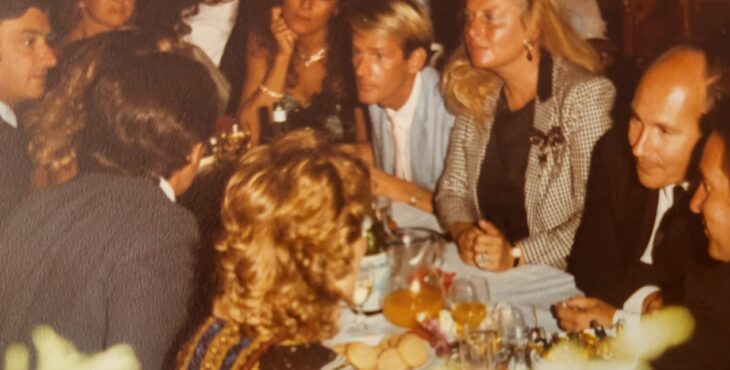Farewell to the king of the Emerald Coast: Prince Karim Aga Khan IV and Porto Cervo
His genius and forward-looking vision led Prince Karim Aga Ahan IV to purchase a vast area in Arzachena in 1962, which then became the Emerald Coast, and the location of a new town called Porto Cervo

His genius and forward-looking vision led Prince Karim Aga Ahan IV to purchase a vast area in Arzachena in 1962, which then became the Emerald Coast, and the location of a new town called Porto Cervo
In addition to being the 650th anniversary of the birth of Michelangelo, 2025 will also be remembered for being 60 years from the death of Winston Churchill, 20 from the death of Pope John Paul II, and for the death of His Royal Highness Karim Aga Khan. At the age of 88, in Lisbon, one of the great protagonists of Sardinia passed away, the man who, in the middle of last century, created the Emerald Coast, one of the most incredible urban, architectural, port, tourist and economic revolutions in the history of post-war Italy: His Highness Karim Aga Khan IV.
It has been over 64 years since Karim Aga Khan IV purchased, in December 1961, from Caterina Ragnedda (overseen by notary Mario Altea from Tempio Pausania), the Stazzo “Fucareddu” over 120 hectares surrounded by the nearby hills of San Pantaleo, to the land before the Rena Bianca beach, between the towns of Antuneddu, Canaleddu and Cuponi. This corner of paradise was his first purchase revealing his true identity and his interest for Sardinia: until then, all his purchases in Monti di Mola, were carefully concluded through a Liechtenstein-based company owned by the Prince.
Wth his genius and forward-looking vision, in 1962 Karim decided to purchase a large area in Arzachena, which he then named Emerald Coast, and where, with architects Jacques Couelle, Luigi Vietti, Michele Burisi Vici and Savin Couelle, he built a new town called Porto Cervo, while along most of the other coastlines in Italy at the time, they were building huge cement hotel blocks. In just a few years, Porto Cervo, with its international marina accommodating over 700 mooring spaces and hospitality services that were the best of their time, became the new place to be for international jet setters, competing with the Cote d’Azur in southern France. The most luxurious yachts of the time vied for a place in front of the new town, juggling for space at a buoy or, for the lucky few, a mooring space in Montecarlo, Cannes, Saint-Tropez and nearby Porto Rotondo, built by Nicolò Donà dalle Rose with his wife, Françoise Marsot Donà dalle Rose.
His Highness Karim Aga Khan, born in 1936, lived between France (Castle Chantilly, Paris, Deauville, Gouvieux) and Switzerland, in Geneva and Gstaad, where he studied before graduating from Harvard. When he was young his passion was winter sports, and he participated in two Winter Olympics, representing Great Britain in 1962 in Chamonix and Iran under the Shah of Persia in 1964 in Innsbruck; he also had a passion for pure-blood horses, which he bred his whole life in his 600-hectare estate, The Haras Aga Khan Studs, in upper Normandy, in Bonneval, not far from the dunes of Deauville. In 1957 Queen Elizabeth II, gave him the title, His Highness and in 1959, the Shah of Persia gave him the title of His Royal Highness.
The original honorific title of the Aga Khan family dates back to 1834, when the Shah of Persia, Fath Ali Shah registered the family under the rank of Princes, after the marriage of Sarv-i Jahan Khanum. The ties between the Shah and England was extremely strong at the time, and was as strong as ever in the post-war period. At just twenty years old, Karim Aga Khan, succeeded his grandfather, Aga Khan III, becoming the forty-ninth hereditary Imam of the Nizari Khoja or Ismaili sect, also known as Assassins, considered to be direct descendants of the Prophet Mohamed through his cousin/son-in-law, Alib Abi Talib, first Imam of the Sciites, and his daughter Fatima. There are over 20 million Ismaili around the world, in particular in India, where the Aga Khan family have a princely residence in Pune. The Ismaili are a people, and nation, that is independent from where they reside, and follow their hereditary Imam, in whom they have unconditional faith, supporting the many philanthropic initiatives which have always been a characteristic of the Aga Khan family.
This prince’s story is incredible. An aristocrat of noble lineage, a talented, forward-thinking entrepreneur, patron, and philanthropist, who took a chance and regenerated an area in `northern Sardinia, which, at the time,was one of the poorest areas in Italy. At that time, these lands near the sea, including ancient Porto Rotondo, where the Romans used to load the granite columns onto ships bound for Rome to built the Parthenon, were considered to be second-class, and left to the females to inherit, as they were considered to be unhealthy and full of malaria.
Destiny, like in a modern fairytale, changed the fate of these ancient Sardinian families, through experiments carried out by the Americans who, departing from the NATO base in Tavolara, used planes to spread DDT throughout the entire area, an insecticide which finally ended the plague of mosquitoes and devaluation of the land. All of a sudden, that same area, which shortly before had no value, became prestigious, reaching impossible prices, that still today are some of the highest in Europe and the world.
But getting back to Prince Karim, as he was known by his closest friends, a living legend whose life was filled with success and huge entrepreneurial exploits, with a particular love for that Sardinia he adored. It is thanks to him that now Olbia has become an international port, easily reached from anywhere around the world, and which, from military airport, became civilian when Alisarda was created in 1963, then recapitalised in 2013 as Meridiana.
In 1962 Karim founded the Consorzio Smeralda and in 1967 he founded Yacht Club Costa Smeralda. Alongside him, other world famous entrepreneurs became part of a consortium that was created to monitor, along with the Comitato Architettura, the urban development of this heaven on earth. Founding partners were, British financier, John Duncan Miller, who was the first person to show him this place, Irish aristocrat and entrepreneur, Patrick Guinness, and his wife, Dolores, the troubled Middle-European writer, René Podbielski of the Roth family, Singer, Von Rezzori, noble Jews who had escaped Poland, Felix Bigio, trusted by the Prince and personal secretary to his father Ali Khan, who died in 1960, and André Ardoin, lawyer to his grandfather, Aga Khan III.
A Venetian Patron to the Gallura coast: Count Nicolò Donà dalle Rose and Porto Rotondo
By strange coincidence, ten years ago, in August 2014, Count Nicolò Donà dalle Rose, born in 1937 died at the age of 77. Today Nicolò would have been 88, like Karim. Nicolò was the oldest child of the Donà dalle Rose family, an ancient noble family of the Donatus lineage, giving life to Neo-Platonic philosopher Girolamo Donà dalle Rose in the XV century, three Venetian Dogi: Francesco, Leonardo and Nicolò Donà dalle Rose, European ambassador Giovan Battista Donà dalle Rose in the XVII century, bailo of the Republic of Venice in Constantinople, during the new period of the Islamic Orient, and Antonio Donà dalle Rose, governor of Palmanova, among others.
In parallel to Kalim Aga Khan, Nicolò Donà dalle Rose created and promoted the new village of Porto Rotondo, south from Porto Cervo. They were the same age, but more than that they were both passionate about sports (boating and skiing), and urbanising, like their forebears. In the early 1960s both were amazed by the uncontaminated beauty of Sardinia, and where they decided to create their ideal cities, differently from what was happening in other parts of Italy’s beaches. Both built two ideal cities, in their own way, and with their own means. Bringing them together was Nicolò’s wife, Françoise Marsot Donà dalle Rose, who, together with her sister Anna Marsot d’Assche, were childhood friend of His Royal Highness Karim Aga Khan and his brother Amyn Aga Khan, racing together on horseback in the dunes of Deauville and the Chantilly countryside while at secondary school in Geneva, where all four had studied.

The Emerald Coast and Gallura in the XXI century
Thinking about it, it almost seems impossible that these incredible, beautiful pieces of land have managed to reach the new millennium unscathed, saved from the expansion of cement jungles that were popular last century, and in particular between the 1960s and 90s. No coast in Italy seems to have escaped this “homicidal” fury that led to the destruction of entire historical cities and the construction of cement monstrosities along the beaches. Two men, two great thinkers, two people who, inspired by the great creators of the past, were able to bravely look to the future and create two sister lands, near and complimentary to each other, in a land that was not theirs, but that they loved and protected like no other before them: Porto Cervo and Porto Rotondo, the Emerald Coast and Gallura.
Karim Aga Khan created a completely new city and a port that could make it the undisputed queen of this part of the sea, which could accommodate some of the biggest and most luxurious yachts in history and their demanding owners and guests. Porto Cervo became a stage where richness, luxury, art and fashion came together through the simplicity and beauty of nature, the sea, and local customs and traditions. Nicolò Donà dalle Rose instead, emulated the Venetians from the past and created a seaside village, inspired by the ancient Venetians who sailed and built cities along the Dalmatian coast, when the Adriatic Sea, from Venice to Cyprus was known as the Gulf of Venice. Centuries, even millennia, have passed, geography has changed, memories have faded and many things have been forgotten, others have even changed , but not thins incredible “international” miracle where two great men, Karim and Nicolò, were champions of the beautiful and the environment, bringing together the country’s economic growth and preservation of the landscape.
Porto Rotondo was founded in 1962, when Nicolò commissioned the Venetian architect and lifelong friend, Alessandro Pianon, to build his home, now Hotel Sporting, while just two years later, in 1964, he founded the Consorzio Porto Rotondo. Consorzio Porto Cervo was already two years old, before the village was built. The two villages grew together, integrating into each other, like two old friends, just like the founders and architects and friends that they both attracted. In particular, engineer, Lucchini, Gianni Gamondi-Antinoli, Piero Castellini, Giancarlo San Gregorio, Gianfranco Fini, Marina Sotgiu, Mario Ceroli, Andrea Cascella, Ascanio Palchetti and Sciarelli.
Yacht Club Porto Rotondo was a natural offshoot of the one in the Emerald Coast, and Nicolò, who was the founder and first president, designed it in every detail, inspired by the Saint Françoise Yacht Club, in Guadalupe, which he had visited with his wife, Françoise, when they were young, and by American cabins, which could be built in just one night. All the events that took place in this area often involved both ports, each one playing to its potential and specific skills, without competing, but with a complementary spirit. Porto Cervo could not compete with any other port, after all: it was already the best.



